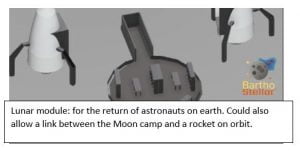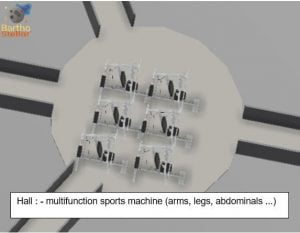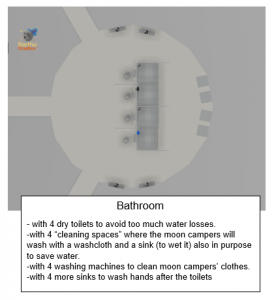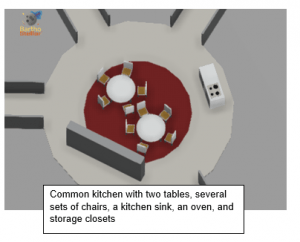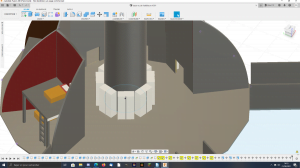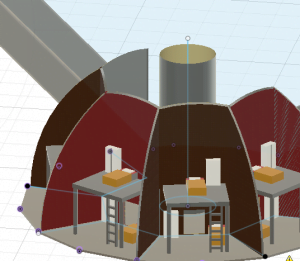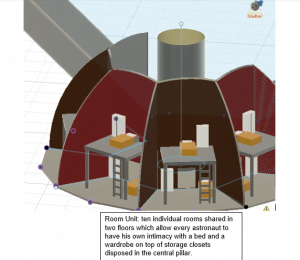Moon Camp Pioneers Gallery 2020-2021
In Moon Camp Pioneers each team’s mission is to 3D design a complete Moon Camp using Fusion 360. They also have to explain how they will use local resources, protect astronauts from the dangerous of space and describe the living and working facilities.
Team: Bartho Stellar
Bartholdi High School Colmar France 17, 18
External viewer for 3d project
|
Project description
Because the astronauts may live on the Moon Camp for several years, or at least for a couple of months, we wanted to provide a functional but not less comfortable place – nothing extravagant. Thus, we have put the living room at the center of the Camp, so the astronauts can easily access it from anywhere in the base to relax a little bit. The sport module will provide the astronauts with the opportunity to take care both of themselves and their bodies. The crew will also have the opportunity to contact their relatives, thanks to the family contact unit. Many domes of the base will also be dedicated to scientific purposes: grow of plants on the Moon, study of lunar rocks, astronomy, etc. We also wanted to make the modules enough large so that several astronauts can be in the same module at the same time. |
|||
|
Where do you want to build your Moon Camp?
Our Moon Camp will be based in a crater on the south pole of the moon. It seems to be the most appropriate place (even if the moon landing will be a little bit more difficult). Indeed, it guarantees protection against UV radiation, thanks to the lesser exposure of the selected areas. This protection is also reinforced by the location of the Camp: a crater – a specific location which furthermore allows for a protection against wind and falling stellar objects like meteorites. The presence of ice near to the chosen area can be an important potential resource of water. This is also why we will choose the southern hemisphere of the Moon to establish the Camp. Finally, we will set up solar panels further ( up? north? south? down? ) on the Moon surface, where they can take advantage of the almost permanent solar exposure of some areas in order to produce energy. How do you plan to build your Moon Camp? Describe the techniques and materials you would use.
The main idea is to use the moon’s resources as much as possible, like regolith, to turn them into usable materials thanks to 3D printing. Once the pieces are built, we plan to assemble them like a classic building site on earth. Therefore, the crew will need manufacturing skills. To make the process as efficient as possible, rover machines imported from earth will be used as well as conventional tools. Concerning the domes, they will be made of regolith, which is easy to find on the Moon. It will be applied on large dome-shaped pieces of fabric once stretched. Thanks to the regolith’s sticking properties, the whole structure will hold. The environment on the Moon is very dangerous for the astronauts. Explain how your Moon Camp will protect them.
Humanely speaking, how can we send people to the Moon without protecting them? And what is the purpose of spending billions of dollars if we do not protect them from meteorites and first and foremost, from the solar and cosmic radiations? Where the astronauts will be protected from radiations thanks to the domes made of regolith, they will be protected from meteorites by the crater. We also have solutions to prevent other risks. If someone is injured, they can be brought to and treated in the infirmary module. Also, if any dome is destroyed, the astronauts will be able to rebuild it relatively easily with replacement dome-shaped pieces of fabric brought to the Moon. And in the event that a 3D-printer stops working, it will be replaced with a new one. Indeed, we think that bringing along one or two 3D-printers to be on the safe side could be wise. Explain how your Moon Camp will provide the astronauts with:
|
|||
|
Water
|
Food
|
Electricity
|
Air
|
|
On the one hand we will collect the ice water that is known to be located near our landing site into huge containers. On the other hand, there will be a water collector system charged to filter urine. This way, no drop of water will be wasted. |
The food will be provided mostly by plants. On account of the absence of pollinating insects in space and in order to save the crew the trouble of pollinating themselves, we will select plants that have an asexual reproduction, like potatoes. We also plan to set up a greenhouse in case some vegetables need more heat, which will also allow the crew to sometimes enjoy fresh fruit as a sugar-packed treat. There also will be dehydrated food as a complement for vegetables. |
Most of the energy will be provided by solar panels, which will turn the sun’s light into electricity. By making water electrolysis we’ll produce dihydrogen, a very useful gas that can be used as a spaceship fuel.Taking advantage of the large amount of helium 3 on the Moon makes it possible to perform helium fusion, another power source. Knowing the explosive nature of this element the fusion would take place far away from the basecamp to avoid any accident. This technique is surely dangerous but it’s safe for the environment on top of producing a huge quantity of power. |
Producing breathable air in space will probably be our greatest challenge therefore we will use several techniques. First, in the short term, the crew will breathe air imported from Earth. It should leave enough time for the plants we imported from earth to produce dioxygen. We especially selected aloe vera, a plant with multiple healing properties, known to be one of the biggest producers of dioxygen besides having very small water needs. On top of those two techniques we also thought of a way to make a water electrolysis that allows us to produce dioxygen and dihydrogen. |
|
Explain what would be the main purpose of your Moon Camp (for example: commercial, scientific, and/or tourist purposes).
The main purpose of our Moon Camp would be a scientific one. Indeed, the Moon is a very mysterious place for the humankind and the only way to know it better is to live on it and make experiments. This Camp shouldn’t become a touristic attraction because pollution would destroy both the Moon and Earth in only few years. It’s essential to keep this adventure for a trained public, that means, for astronauts and scientists. Finally this project represents a real human dream come true. Nowadays, space is one of the only areas which is a complete mystery for us. By proving that living on the Moon is an achievable purpose we also send a message: we can push the boundaries of reality and conquer new worlds. |
|||
|
Describe a day on the Moon for your Moon Camp astronaut crew.
A typical day for one of our astronaut crew begins at 7 AM in their own room. Then he / she goes to the common kitchen and can enjoy an invigorating breakfast mainly based on potatoes. In the first place the main job for every crew member will be to build the moon camp. Once this phase is over each astronaut is going to have his own occupation. Most of their time will be devoted to research in different areas: the study of lunar rocks, the effects of long term zero gravity on the human body, the evolution of plants in space or astronomy. In the long term it would also be interesting to extend the main basecamp to create new ones depending on the needs. For example, if there appears to be a huge quantity of water on the moon, an aquatic unit could be useful to grow seaweed, an enormous producer of dioxygen. Of course, there will also be some general maintenance to do every day. Because of the lack of pollinating insects, potatoes which can be cloned are a very useful way of producing food. However, eating the same meal everyday can result in a very sad routine, therefore, in the longer run, engaging in hand-fertilization of a greater variety of plants could significantly improve the crew’s morale by varying the meals. Living on the Moon is, first of all, a great adventure for those scientists but shouldn’t be felt as a pain, that’s why there will also be relaxing time during the day. There will be plenty of activities such as reading, watching DVDs or games in the living room. To keep fit, which is essential in space, we also devised a sports room with equipment. Finally we reckon that keeping in touch with our peers is one of the most important things to do (especially when we are 239 thousand miles away) therefore we set up a family contact unit to be able to check on your loved ones even in space. |
|||


